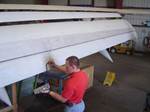Low-cost ultrasonic NDT method yields real-time results
Ultrasonic nondestructive inspection methods are based on the principle of wave propagation through a solid medium. A transmitter emits a sound wave, above the range audible to humans, that excites the structure, while the same (or a second) transducer picks up the resulting structural waves. In a typical setup, a C
The DAV excites a large-area, unfocused transducer, which generates a collimated plane wave. As the resulting wave strikes the target and scatters, an acoustic lens collects the scattered energy and focuses it onto an ultrasound-sensitive detector array in either through-transmission mode or "pulse echo" mode, in which the transducer is at an angle to the part surface. The camera is placed in intimate contact with the part via an acoustic coupling gel or compliance pads or membranes; the camera housing is water-filled to minimize signal attenuation.
The technology has been tested by the U.S. Air Force Air Mobility Battlelab (Ft. Dix, N.J.) and by a commercial aircraft OEM. In the latter case, a 26-inch by 7-inch (660 mm by 178 mm) monolithic carbon/epoxy test panel, varying in thickness from 0.375 inch to 1.5 inches (9.5 mm to 38.1 mm), was constructed with known defects. The Imperium I500 Acoustocam device, in pulse echo configuration, enabled the examiner to view the sample at various depths in real time, at 30 frames per second, to 0.02 inch/0.5 mm resolution, says Lasser. Including setup, the scan was completed within 15 minutes.
Related Content
-
Laser NDT, DIC systems demonstrate optimized noncontact composites inspection
CAMX 2024: Dantec Dynamics is presenting three of its laser shearography NDT and DIC devices, geared toward reliable measurement results.
-
Automated robotic NDT enhances capabilities for composites
Kineco Kaman Composites India uses a bespoke Fill Accubot ultrasonic testing system to boost inspection efficiency and productivity.
-
Xnovo Technology, Exciscope introduce X-ray tensor tomography technique
Through a strategic partnership, the companies introduce the FiberScanner3D module, dedicated to bringing more rapid, reliable and robust fiber structure characterization methods to lab settings.










.jpg;maxWidth=300;quality=90)
